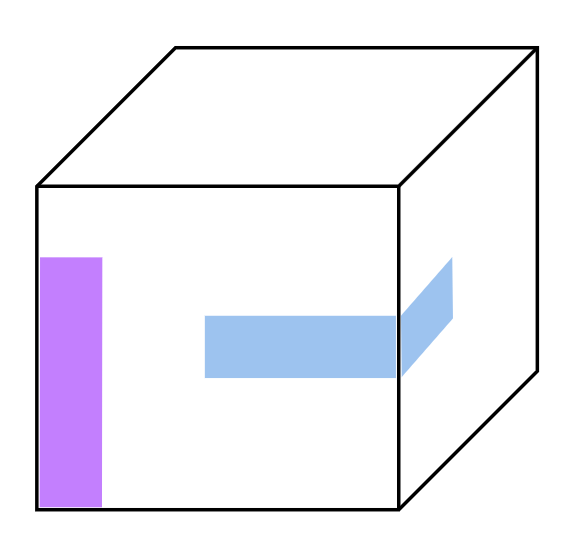Problems
Imagine you have a cube (a box with six square sides). First, cut 16 identical colourful rectangular paper strips of any size you like (choose one size and make all 16 the same). Can you cover the entire outside surface of the cube with these strips, with no gaps and no overlapping? The strips may bend and wrap around edges and corners, but after cutting the 16 strips, you are not allowed to cut them again, and everything must stay on the cube’s surface. Is it possible? Explain why or why not. (For example, two of the strips may look like this:

a) In the context of Example 2 assume we have some number of parcels each weighing different amount of kilograms. We still have 3 identical cars of equal capacities (in numbers of packages) and we still want to distribute parcels in such a way that each car has the same total weight of parcels. Knowing that the number of parcels is not greater than 100 find the maximum and the minimum amounts of packages for which it is possible.
(b) Now we have 3 trucks so we do not really care about the sizes of parcels and their number. But yet we need to satisfy the condition of equal total weights of parcels in each vehicle. Can we do so if there are 27 packages weighing 1 kg, 2 kg, ..., 27 kg?
A battalion of soldiers was marching towards a captured city. Their progress was stopped by a wide river. Fortunately, close to the shore there were two boys sailing in a small boat. They escaped from the city and were eager to help the soldiers to cross the river. The only obstacle was that their boat could fit either two boys or one soldier. Taking into account one person was enough to handle that kind of boat (i.e. to sail from one shore to another) and the fact that on the next day the city was liberated so the boys could reunite with their families describe how the battalion was capable of crossing the river.
The cube from Example 3 is a present and one layer of a gift-wrap is totally not enough. Can you cover it with another 15 identical rectangles? You can assume the covering from Example 3 was thin and it did not affect the shape of a cube. As before no overlappings are allowed and the surface has to be fully covered by rectangles.
(a) Jimmy is working on a metal model of a grasshopper. He named it Kimmy. The boy keeps on adding new features to his robot. Besides being an accurate alarm clock, Kimmy can jump in one or two cells depending on how many times Jimmy claps his hands. Do you think the boy can choose a sequence of claps in such a way that the robot will visit all cells of a \(1\times101\) strip?
(b) What if the task is to visit all cells of a \(1\times99\) strip?
Two clowns A and B are playing the following game. They have 33 tomatoes on a plate. One of the tomatoes is rotten and both clowns know which one. Each move they can choose one, two, or three of the remaining tomatoes from the plate and smash them into their own faces. They take turns and the clown who chooses the rotten tomato looses the game. They cannot skip the moves. Clown A starts the game. Does A or B have a winning strategy? (A winning strategy is a strategy following which you win no matter how your opponent plays.)
There are 30 people standing in a queue in front of a candy shop. We know that among every ten people standing one after another there are more adults than kids. Is it possible that among all 30 people there are more kids than adults?
Half an hour later (see example 3) there are only 15 people standing in the queue. The condition about every ten consecutive members of the queue is still satisfied. Can we guarantee that there are more adults than kids?
Three liberals and three democrats are about to cross the river. The only available boat has two seats. The difficult part is that the democrats do not want to be outnumbered on any of the shores while the boat is on water (they are afraid in such case they will get pushed into the river by the liberals). To avoid another civil war you need to organise their transit properly.
Ten ladies and ten gentlemen regularly attend a dancing club. Last week the participants gave a short performance for their relatives and friends. They showed ten different dances. Every gentleman had a chance to dance once with every lady. It turns out that every lady danced her next dance with either blonder or taller partner than the previous dance. Explain how that could be possible.